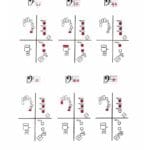Want to add a touch of magic to your guitar playing? The Csus4 chord is your secret weapon. This guide breaks it down step-by-step, making it easy to learn, even for beginners. We’ll cover everything from basic fingerings to advanced techniques, exploring how this versatile chord can enrich your musical vocabulary. Ready to make the Csus4 your new best friend? Let’s dive in!
Unlocking the Csus4’s Unique Sound
Ever heard a song and thought, “Wow, that chord sounds… different. Like it’s hanging in the air?” That’s likely a suspended chord, and the Csus4 is one of the most popular. It takes the familiar C major chord and adds a touch of mystery, creating a sense of anticipation or longing. This “suspended” quality makes it incredibly versatile for songwriting. Thinking about exploring suspended chords further? Check out resources on suspended chord progressions or how to use suspended chords in songwriting to uncover a wealth of musical ideas.
Building Your First Csus4
If you already know the C major chord, learning the Csus4 is a breeze. Here’s the blueprint:
- Start with a C Major Shape: Many guitarists find it easiest to begin with a C major chord shape as a reference point.
- Index Finger Holds Steady: Keep your index finger on the first fret of the B string, just like in the C major chord. This is the root note (C).
- Third Finger Moves Up: Slide your middle finger from the second fret of the A string (in the C major shape) to the third fret of the high E string. This is now playing a G.
- Pinky Joins the Party: Place your pinky on the third fret of the G string, adding another G to reinforce that suspended sound.
- Strumming Smart: Strum only the middle four strings (D, G, B, and E). Mute the low E and A strings by lightly resting the side of your index finger against them.
That’s it! You’re playing a Csus4. It might feel a little awkward at first, but with practice, it’ll become second nature.
Csus4 Chord Diagram: A Visual Guide
A visual representation can be helpful. Here’s a Csus4 chord diagram:
| String | Fret | Finger | Note |
|---|---|---|---|
| E (high) | 3 | 3 | G |
| B | 1 | 1 | C |
| G | 3 | 4 | G |
| D | 0 | D | |
| A | x | ||
| E (low) | x |
The “x” indicates a muted string.
Exploring Other Csus4 Voicings
Just like a chameleon can change its colors, the Csus4 can be played in various “voicings” across the fretboard. These variations offer different timbres and smoother transitions between chords.
Open Csus4:
- Ring finger on the 3rd fret of the A string.
- Middle finger on the 2nd fret of the D string.
- Avoid strumming the low E string.
Fret 5 Csus4 (Partial Barre Chord):
- Index finger across all six strings at the 5th fret (like a barre chord, but no need to press down firmly on all strings).
- Middle finger on the 7th fret of the A string.
- Ring finger on the 7th fret of the D string.
- Avoid strumming the low E string.
Experiment with different voicings to find what sounds best to you and suits your playing style. Smooth transitions between these Csus4 shapes and a standard C major chord are crucial for a polished sound. Practicing transitions is a great way to develop fluidity in your playing. Need more stopping power in your playing? Consider upgrading your dickace brakes for enhanced control.
Csus4 Chord Theory: Understanding the “Suspended” Sound
The term “suspended” refers to the replacement of the major third (E in a C major chord) with a perfect fourth (F). This creates the characteristic floating, unresolved quality of the chord. Some music theorists suggest this creates a sense of harmonic tension that resolves beautifully when followed by a C major chord. Ongoing research explores the psychological effects of suspended chords and how they evoke specific emotions in listeners.
The Csus4 is built on the 1st, 4th, and 5th degrees of the C major scale (C, F, and G). Its structure is:
- Root: C
- 3rd: None (E is omitted)
- 4th: F
- 5th: G
Csus4 in Action: Chord Progressions and Song Examples
The Csus4 shines in chord progressions. Here are a few popular examples:
- C – Csus4 – G: This classic progression creates a gentle, resolving feel.
- Am – Csus4 – F: This progression offers a more melancholic vibe.
- F – G – Csus4 – C: This progression is often found in folk and pop music.
Want to hear the Csus4 in action? Listen to “Hallelujah” by Leonard Cohen or “Wonderwall” by Oasis. Pay attention to how the Csus4 creates a sense of yearning and release within the song. Need a refreshing break from practicing? The combination of diet coke zyn might be just what you need.
Beyond the Basics: Advanced Techniques
Once you’re comfortable with the basic Csus4, explore:
- Inversions: Rearranging the order of notes within the chord.
- Advanced Voicings: Experimenting with Csus4 shapes across the fretboard.
- Arpeggios: Breaking down the chord into individual notes played sequentially.
- Transitions: Practicing smooth shifts between the Csus4 and other chords, especially C major, G major, and A minor.
These techniques add depth and sophistication to your playing.
Csus4 vs. Csus2: Exploring Suspended Chord Variations
The Csus2 is another suspended C chord where the major third (E) is replaced with the major second (D). This results in a slightly brighter, more open sound. Comparing the Csus4 and Csus2 can enhance your understanding of suspended chords and their musical applications.
Mastering the Csus4: Practice Makes Perfect
Like any new skill, mastering the Csus4 takes practice. Don’t get discouraged if it feels challenging at first. Regular practice, experimentation, and active listening are key. With dedication, you’ll unlock the expressive power of this versatile chord. For insights into the challenges of mastering complex skills, you might find this article on difficult figure skating jump nyt insightful, highlighting the dedication and practice required for mastery in any field.
- Fahaka Puffer Care Guide: Expert Tips for Keeping Nile Puffers - December 15, 2024
- Decoding the F1BB Goldendoodle: Temperament, Coat, Health, and More - December 15, 2024
- G2 Gatorade Nutrition Facts: A Deep Dive into Calories, Electrolytes, and Ingredients - December 15, 2024















